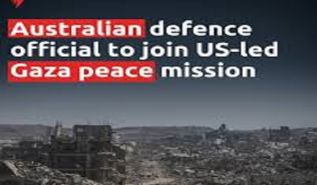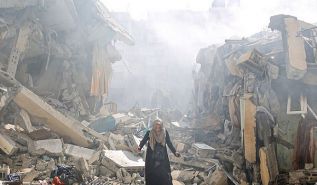بسم الله الرحمن الرحيم
The Emergence of Two New Military Alliances in the Middle East, the Caucasus, and South Asia
Al-Rayah Newspaper – Issue 553 – 25/06/2025 AH
(Translated)
By: Ahmad Al-Khatwani
An alliance between Pakistan, Turkey, and Azerbaijan has been gradually taking shape in an organized manner, since the leaders of the three countries met at a summit in the summer of 2024. The summit brought together Turkish President Erdogan, Pakistani Prime Minister, Shehbaz Sharif, and Azerbaijani President, Ilham Aliyev. It focused on political relations among the three states, and addressed regional and global issues such as Gaza, Cyprus, Kashmir, and the matter of Islamophobia.
It was decided to elevate the trilateral cooperation, which had previously held meetings at the level of parliamentary speakers and foreign ministers, to the level of heads of state. Emphasis was placed on expanding opportunities for cooperation among these three states, which were described as friendly and brotherly nations. The aim is to strengthen their collaboration in a way that contributes to the prosperity of their peoples, and promotes regional and global peace and stability.
The summit emphasized the importance of cooperation among the three states in combating transnational threats, particularly what has been referred to as terrorism, and affirmed their joint resolve to address it as a danger to all.
Historically, Turkish-Pakistani coordination on regional stances emerged as early as 1950, when Turkey supported Pakistan over the Kashmir issue. Later, both countries, along with Iraq, joined the Baghdad Pact, which was backed by Britain to counter America’s agent in the region, Egypt’s ruler Jamal Abdel Nasser, as part of the US-British rivalry over the Middle East during the 1950s.
However, real military relations between Pakistan and Turkey began after 2015, involving defense coordination between the two countries. Joint military production was significantly increased, along with economic cooperation particularly in activating the Chinese Silk Road, for transporting goods from China to Pakistan, then to Turkey, and onward to Europe.
As for the Western powers, especially the United States, this intensive bilateral cooperation between two major and important regional powers does not cause significant concern, since Turkey is a member of NATO and fully committed to the alliance’s terms and conditions. This, in turn, draws Pakistan into a form of indirect dependence on NATO, effectively placing it under more Western influence by extension.
However, there is some unease in the United States over Pakistan’s alignment with China, at the expense of India, Washington’s ally and a key member of the Quad summit, an international political bloc that includes the US, India, Japan, and Australia. Nevertheless, this unease does not significantly affect the core of international relations with Pakistan and Turkey.
To address this partial imbalance, especially after the recent clash between India and Pakistan, and to counterbalance the Pakistani-Turkish-Azerbaijani alliance, with an equivalent bloc consisting of India, Iran, and Armenia, India responded to Turkey’s arming of Azerbaijan by supplying weapons to Armenia. This came after Russia’s withdrawal from the region, following the Nagorno-Karabakh war, and Armenia’s defeat by its rival Azerbaijan, as well as Russia’s abandonment of Armenia and its stance of neutrality.
India has indeed begun increasing its arms exports to Armenia, in a clear move aimed at countering the growing strategic alliance between Turkey, Azerbaijan, and Pakistan. India views this trilateral alliance as explicit hostility toward it, with clear military and political dimensions, that directly challenge its regional interests. India sees this alignment as an open stance against it, especially in the aftermath of the recent conflict between India and Pakistan.
In 2022, a contract worth $244.7 million was signed between India and Armenia, under which India would supply Armenia with the Pinaka Multi Barrel Rocket Launcher (MBRL), along with a range of ammunition and support equipment. The deal is estimated to include no fewer than four batteries, and also covers mortar shells, anti-tank missiles, and other types of munitions.
In 2023, the Indian company Kalyani Strategic Systems Limited (KSSL) signed a $155.5 million agreement to supply Armenia with 155mm artillery guns, as part of strengthening military ties between the two countries. In the same year, specifically at the end of October 2023, the Indian company Zen Technologies, specializing in military simulation systems and anti-drone technologies, announced the export of such equipment to Armenia worth $41.5 million. In 2024, Armenia signed another deal to procure Akash air defense systems in undisclosed quantities, making Armenia one of the largest importers of Indian defense products, and positioning India as one of Armenia’s key arms suppliers.
The United States, of course, clearly leans in favor of India over Pakistan. It imposes restrictions on the use of American-exported aircraft to Pakistan, such as the F-16s and others, preventing their actual use against India. These aircraft are limited to defensive purposes, or permitted solely for use against jihadist movements.
For its part, Iran stands with Armenia and India in a bloc opposing the Pakistan-Turkey-Azerbaijan axis. Iran recently thwarted the Zangezur Corridor project, which aimed to connect Turkey and Azerbaijan to Central Asian states, such as Kazakhstan, Uzbekistan, Kyrgyzstan, and Turkmenistan. By doing so, Iran has blocked Turkey’s access to the Turkic-speaking countries, serving as a geopolitical barrier, to prevent these states from forming any kind of union or alliance.
Thus, two opposing and hostile trilateral alliances have been formed in the Middle East, the Caucasus, and South Asia: the Pakistan-Turkey-Azerbaijan alliance versus the India-Iran-Armenia alliance. Each bloc includes two major regional players, one of them a nuclear state, and one smaller, affiliated country. The formation of these blocs has created a form of regional balance, that helps prevent instability in the area, following Russia’s withdrawal from the scene.




